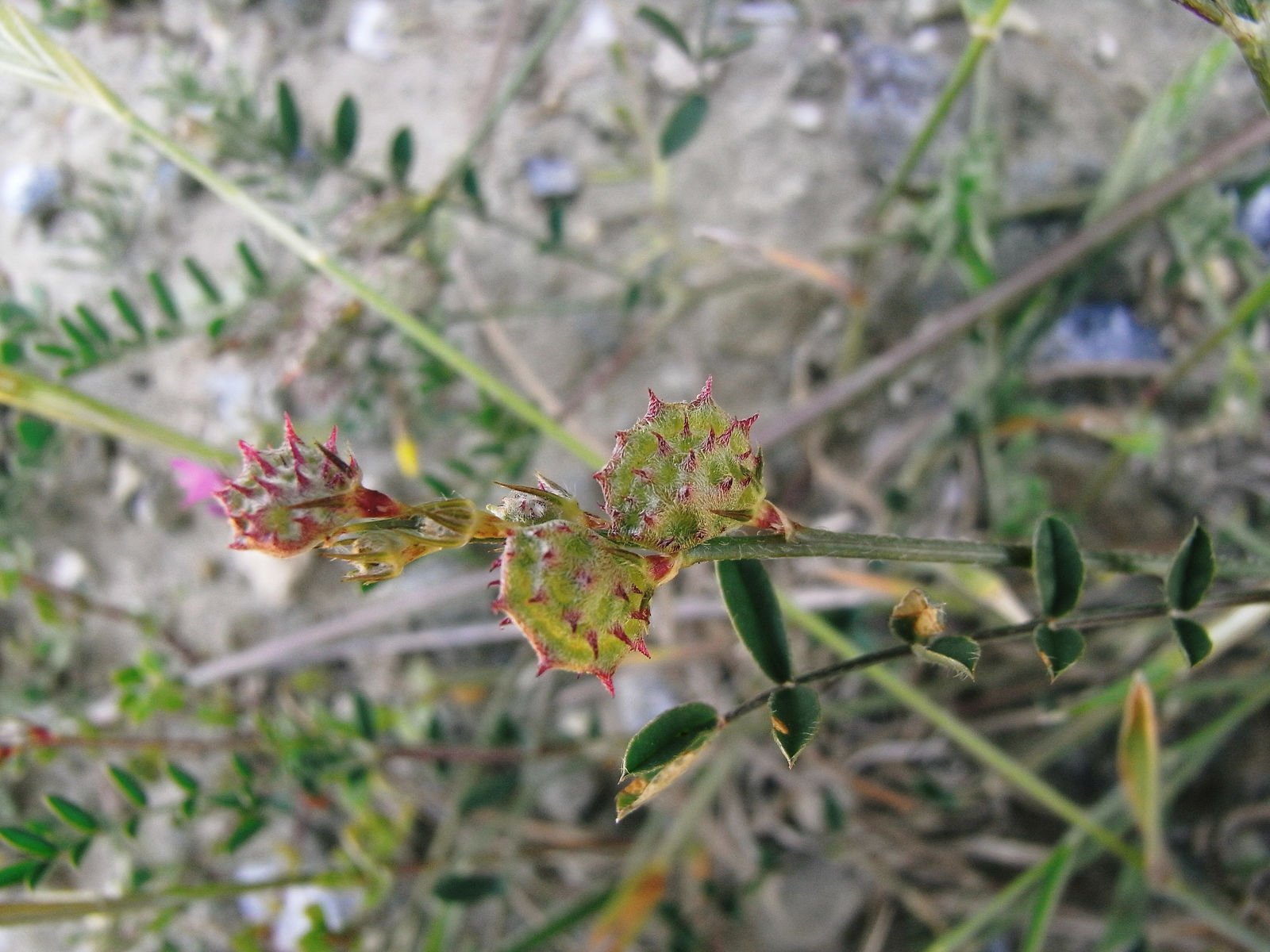Cock's Head Vetchling
onobrychis caput-galli
Also known as: ["Cock's Head","Sainfoin"]
Overview
A perennial legume with spikes of pinkish-white flowers, native to Europe and Asia.
Benefits & Perks
["wildlife attractant (bees, butterflies, birds)","drought tolerant","edible fruits"]
Botanical Classification
| Phylum: | Magnoliophyta |
| Class: | Magnoliopsida |
| Order: | Fabales |
| Family: | Fabaceae |
| Genus: | Onobrychis |
| Botanical Name: | Onobrychis caput-galli |
Plant Characteristics
Basic Information
- Category: Herbs & Weeds
- Suitable Location: rock gardens, slopes, or open meadows
- Suitable For:
- Is Weed: No
- Allergenicity: low
Environmental Needs
- Climate: {"temperatureRange":"5–35°C"}
- Hardiness: {"zones":"4–8"}
- Misting: rarely required, only if ambient humidity is very low
- Drainage: Fast-draining to prevent waterlogging.
- Soil Type: Well-draining, sandy loam with some organic matter.
Maintenance Level
- Maintenance Level: low
- Toughness Level: high
- Pruning Frequency: As needed, typically after flowering or in early spring.
- Pruning Intensity: Light to moderate; avoid heavy pruning unless necessary.
Care Details
Ideal Sunlight Coverage:
Full sun (6–8 hours/day); tolerates partial shade in hot climates.
Sunlight Tolerance Tips:
Acclimate gradually to intense sunlight; protect from harsh midday sun; adjust placement based on seasonal light changes.
Care Requirements
Care Difficulty
easymoderate
Sunlight
full sun to partial shade
Rotate plant for even light exposure; use sheer curtains in intense sun; monitor for sunburn.
Watering
every 7–10 days during active growth, reduce in winter
Water thoroughly but infrequently; ensure proper drainage; avoid wetting foliage.
Soil
well-drained, sandy loam with moderate organic matter
pH: Slightly alkaline to neutral (pH 6.5–7.5).
Ensure soil dries between waterings; avoid heavy clay soils; amend with organic matter for nutrients.
Temperature
Prefers 60–75°F (15–24°C); tolerates cooler temperatures but avoids frost.
Avoid sudden temperature shifts; protect from drafts; maintain consistent warmth.
Fertilizing
every 4–6 weeks during growing season, none in winter
Apply fertilizer to moist soil to prevent root burn; flush soil occasionally to prevent salt buildup; stop fertilizing before dormancy.
Propagation
Methods
Seed or division; seeds germinate best after a period of cold stratification.
Step-by-Step Propagation Guide
- Sow seeds shallowly, keep moist.
- Divide clumps carefully, replant immediately.
Best Time: Spring or early autumn when temperatures are mild.
Environment
Warm (65–70°F), high humidity, and indirect light for seeds; division requires similar conditions to mature plants.
Medium
Well-draining seed starting mix or sandy loam.
Hormone
Not required for seeds; division does not need hormone.
Timeline
Seeds may take 2–4 weeks to germinate; division establishes quickly in 2–4 weeks.
Tools Needed
Seed trays, pruners, gloves, watering can
Quick Tips
Cold stratify seeds for better germination; divide plants when overcrowded to maintain vigor.
Pruning & Repotting
Pruning Guide
Method
Snip dead or weak stems at the base; shape lightly if desired.
Pruning Plan
Minimal pruning needed; focus on removing dead or damaged growth to maintain plant health.
Tools
Pruning shears, gloves
Checklist
Sanitize tools, prune dead growth, avoid over-pruning
Repotting Guide
Best Season
Early spring before new growth begins.
Pot Size
Move to a pot one size larger (1–2 inches wider in diameter).
Method
Remove plant gently, trim roots if crowded, replace with fresh soil mix, ensure good drainage.
Suggestions
Repot every 2–3 years or when roots fill the container; beneficial for mature plants to refresh soil.
Checklist
Choose appropriate pot, prepare new soil, handle roots carefully, water after repotting
Advanced Care Tips
Watering Mastery
Watering Checklist
Check soil moisture, water deeply, ensure drainage, avoid foliage wetting
How to Apply Water Properly
Water at the base of the plant, ensuring moisture reaches the root zone; allow excess water to drain away; water early in the day to minimize evaporation.
Watering Schedule Tips
Water deeply once the top inch of soil is dry; reduce frequency in winter to prevent root rot.
Soil Improvement
Add perlite or coarse sand for drainage; incorporate compost for fertility.
Temperature Stress Management
Signs of Temperature Issues
Wilting, leaf scorch, stunted growth, or premature flowering.
Cold Stress
Slows growth, may cause leaf drop or dieback if exposed to freezing temperatures.
Solution: Protect from frost with mulch or move to a sheltered location; avoid overwatering in cold.
Hot Stress
Leaves may wilt or scorch; growth may slow under prolonged high heat.
Solution: Provide shade during peak heat; increase watering frequency; ensure good air circulation.
Fertilizing Guide
Fertilizing Checklist
Use diluted fertilizer, apply during growing season, avoid winter feeding
Fertilizing Method
Use a balanced, water-soluble fertilizer diluted to half strength; fertilize every 4–6 weeks during growing season (spring/summer); avoid fertilizing in winter.
Common Problems & Solutions
Toxicity Warning
Cats
Non-toxicOnobrychis caput-galli is not known to be toxic to cats under normal circumstances.
⚡ Toxic If:
Not applicable
Dogs
Non-toxicOnobrychis caput-galli is not known to be toxic to dogs under normal circumstances.
⚡ Toxic If:
Not applicable
Humans
Non-toxicOnobrychis caput-galli is not known to exhibit toxic properties to humans under normal circumstances.
⚡ Toxic If:
Not applicable
Frequently Asked Questions
Q: Is Onobrychis caput-galli edible?
A: Yes, it is used as forage for livestock and has some culinary uses.
Q: Does this plant attract wildlife?
A: Yes, it attracts bees, butterflies, and birds due to its nectar-rich flowers.
Q: How drought-tolerant is this plant?
A: It is highly drought-tolerant and thrives in dry, sunny conditions.
Quick Reference
| Family: | Fabaceae |
| Care: | easy |
| Light: | full sun to partial shade |
| Water: | every 7–10 days during activ |
Get Expert Care Tips
Download the Plantious app for personalized care reminders and plant identification!
Google Play App Store








